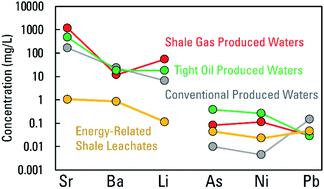当前位置:
X-MOL 学术
›
Environ. Sci.: Processes Impacts
›
论文详情
Our official English website, www.x-mol.net, welcomes your
feedback! (Note: you will need to create a separate account there.)
Water–rock interaction and the concentrations of major, trace, and rare earth elements in hydrocarbon-associated produced waters of the United States
Environmental Science: Processes & Impacts ( IF 4.3 ) Pub Date : 2021-07-26 , DOI: 10.1039/d1em00080b Carleton R Bern 1 , Justin E Birdwell , Aaron M Jubb
Environmental Science: Processes & Impacts ( IF 4.3 ) Pub Date : 2021-07-26 , DOI: 10.1039/d1em00080b Carleton R Bern 1 , Justin E Birdwell , Aaron M Jubb
Affiliation

|
Studies of co-produced waters from hydrocarbon extraction across multiple energy-producing basins have generally focused on major ions or a few select tracers, and studies that examine trace elements and involve laboratory experiments have generally been basin specific. Here, new perspective is sought through a broad analysis of concentration data for 26 elements from three hydrocarbon well types using the U.S. Geological Survey National Produced Waters Geochemical Database (v2.3). Those data are compared to leachates (water, hydrochloric acid, and artificial brine) from 12 energy-resource related shales from across the United States. Both lower pH and higher ionic strength were associated with greater concentrations of many trace elements in produced waters. However, individual effects were difficult to distinguish because higher ionic strengths drive decreases in pH. Water–rock interactions in the leaching experiments generally replicated produced water concentrations for trace elements including Al, As, Cd, Co, Cu, Mo, Ni, Pb, Sb, Si, and Zn. Enhanced middle rare earth element (REE) mobilization relative to shale REE content occurred with low pH leachates. Produced water concentrations of Li, Sr, and Ba were not replicated by the leaching experiments. Patterns of high Li, Sr, and Ba concentrations and ratios relative to other elements across produced waters types indicate controls on these elements in many settings related to pore space pools of salts, brines, and ion-exchange sites affected by diagenetic processes. The size of those pools is diluted and masked by other water–rock interaction processes at the water–rock ratios necessitated by laboratory experiments. The results broadly link water–rock interaction processes and environmental patterns across a wide variety of produced waters and host formations and thus provide context for trace element data from other environmental and laboratory studies of such waters.
中文翻译:

美国与碳氢化合物相关的采出水中的水-岩相互作用和主要、痕量和稀土元素的浓度
对跨多个能源生产盆地的碳氢化合物开采的联产水的研究通常集中在主要离子或少数选择的示踪剂上,而检查微量元素和涉及实验室实验的研究通常是针对特定盆地的。在这里,通过使用美国地质调查局国家采出水地球化学数据库 (v2.3) 对来自三种油气井类型的 26 种元素的浓度数据进行广泛分析,寻求新的视角。这些数据与来自美国各地的 12 个与能源相关的页岩的渗滤液(水、盐酸和人工盐水)进行了比较。较低的 pH 值和较高的离子强度都与产出水中的许多微量元素浓度较高有关。然而,个体效应难以区分,因为较高的离子强度会导致 pH 值降低。浸出实验中的水-岩相互作用通常复制了微量元素(包括 Al、As、Cd、Co、Cu、Mo、Ni、Pb、Sb、Si 和 Zn)的产出水浓度。与页岩 REE 含量相关的中稀土元素 (REE) 动员增强发生在低 pH 浸出液中。浸出实验未复制 Li、Sr 和 Ba 的产出水浓度。不同采出水类型的高 Li、Sr 和 Ba 浓度和相对于其他元素的比例表明,在与盐、盐水和受成岩过程影响的离子交换位点的孔隙空间池相关的许多环境中,这些元素受到控制。这些水池的大小被其他水岩相互作用过程稀释和掩盖,以实验室实验所需的水岩比例。结果广泛地将各种采出水和宿主地层的水-岩相互作用过程和环境模式联系起来,从而为来自此类水域的其他环境和实验室研究的痕量元素数据提供了背景。
更新日期:2021-07-26
中文翻译:

美国与碳氢化合物相关的采出水中的水-岩相互作用和主要、痕量和稀土元素的浓度
对跨多个能源生产盆地的碳氢化合物开采的联产水的研究通常集中在主要离子或少数选择的示踪剂上,而检查微量元素和涉及实验室实验的研究通常是针对特定盆地的。在这里,通过使用美国地质调查局国家采出水地球化学数据库 (v2.3) 对来自三种油气井类型的 26 种元素的浓度数据进行广泛分析,寻求新的视角。这些数据与来自美国各地的 12 个与能源相关的页岩的渗滤液(水、盐酸和人工盐水)进行了比较。较低的 pH 值和较高的离子强度都与产出水中的许多微量元素浓度较高有关。然而,个体效应难以区分,因为较高的离子强度会导致 pH 值降低。浸出实验中的水-岩相互作用通常复制了微量元素(包括 Al、As、Cd、Co、Cu、Mo、Ni、Pb、Sb、Si 和 Zn)的产出水浓度。与页岩 REE 含量相关的中稀土元素 (REE) 动员增强发生在低 pH 浸出液中。浸出实验未复制 Li、Sr 和 Ba 的产出水浓度。不同采出水类型的高 Li、Sr 和 Ba 浓度和相对于其他元素的比例表明,在与盐、盐水和受成岩过程影响的离子交换位点的孔隙空间池相关的许多环境中,这些元素受到控制。这些水池的大小被其他水岩相互作用过程稀释和掩盖,以实验室实验所需的水岩比例。结果广泛地将各种采出水和宿主地层的水-岩相互作用过程和环境模式联系起来,从而为来自此类水域的其他环境和实验室研究的痕量元素数据提供了背景。











































 京公网安备 11010802027423号
京公网安备 11010802027423号